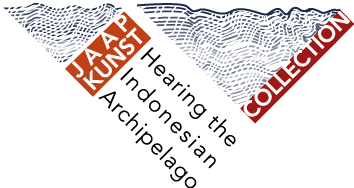The Collection
Instruments from Papua, Indonesia. Photo by Jaap Kunst
Jaap Kunst Collection
Jaap Kunst and Katy Kunst-Van Wely recorded music on wax cylinders, collected musical instruments, took photographs and shot silent film on the islands of Java, Bali, Sumatra, Celebes (Sulawesi), Nias, Sumba, Flores, Timor, the Kai Islands, Banda, and Waigeo. They also recorded music from Sumatra, Kalimantan, Sulawesi and the Moluccas with musicians visiting Java. Missionary Father Verschueren and army officer C.C.F.M. le Roux recorded music in West Papua on Kunst’s request. Pastor Pieter Middelkoop sent his Timorese recordings to him in order for them to be galvanized and copied. Kunst’s wax cylinder collection encompasses more than 300 indexed items recorded by Kunst & Kunst-Van Wely, about 25 indexed items from Father Verschueren, and around 50 indexed items recorded by Le Roux.
Kunst sent his sound recordings directly from Batavia to Berlin where Erich von Hornbostel galvanized and copied them at the Berlin Phonogramm-Archiv. The Phonogramm-Archiv sent copies to the Colonial Institute in Amsterdam (later Royal Tropical Institute). When Kunst left the Indies in 1934, he left the musical instrument collection at the Museum of the Koninklijk Bataviaasch Genootschap (Royal Batavian Society). The instruments are currently maintained by the National Museum in Jakarta.
Jaap Kunst in Papua, Indonesia
Kunst devoted special attention to maintaining his social and professional relations through written correspondence. Not only did he keep the letters he received, he also kept copies of the letters he sent out. Thus, the Jaap Kunst collection holds ca. 10,000 letters, including scholarly correspondence, from the period 1920–1960 encompassing 40,000 pages. These letters include scholarly correspondence to colleagues in the Dutch East Indies, Germany, the Netherlands, Britain, to members of the Javanese nobility, government officials, universities, museums and professional societies. Correspondence before 1940 has been indexed. Correspondence after 1940 is ordered chronologically, but has not been indexed. The collection also encompasses research reports; about 6,000 projection slides for teaching purposes with images of musicians, musical instruments, orchestras, music transcriptions, dance forms, mostly taken from books and periodicals; 1,600 glass plates (copies from the National Museum in Jakarta); 6,500 photographs of musical instruments, dance and theatre practices, and numerous music practices.
When Jaap Kunst passed away in 1960, Katy Kunst-Van Wely sold the collection in order to make ends meet to the University of Amsterdam (UvA), where Kunst had been teaching since 1942. Kunst’s assistants and successors Ernst Heins and Felix van Lamsweerde maintained and enlarged Kunst’s collection with material from their own collections and those of their students and colleagues. They also inherited similar cataloguing styles from him. Heins founded the Ethnomusicologisch Centrum Jaap Kunst (ECJK) at the UvA that was dismantled in the early 2000s. Kunst’s written archive (correspondence, reports, photographs, teaching material, manuscripts) is currently stored at the UvA’s Special Collections division at the University’s Allard Pierson Museum. Kunst’s library was usurped in the University Library’s general collection. The sound archive of the ECJK (with recordings from many parts of the world, recorded by Kunst’s students and successors on a range of sound carriers) is still part of the musicology department and is currently in the process of being digitized. New discoveries of letters and photographs by Kunst’s granddaughter Clara Brinkgreve enlarged the existing collection in the summer of 2021.
Flores, Indonesia. Photo by Jaap Kunst
